How to create your own 4337 metrics?¶
Step-by-step guide on how to use the Optimism Superchain’s public BigQuery datasets to create custom 4337 metrics, analyze Paymaster usage, and enrich insights with BundleBear’s labeled on-chain addresses.¶
Using OP Foundation 4337 dataset¶
In order to utilize the Superchain and 4337 datasets for your own purposes you need to Subscribe to the Google BigQuery datasets here and from there you can experiment with the data:
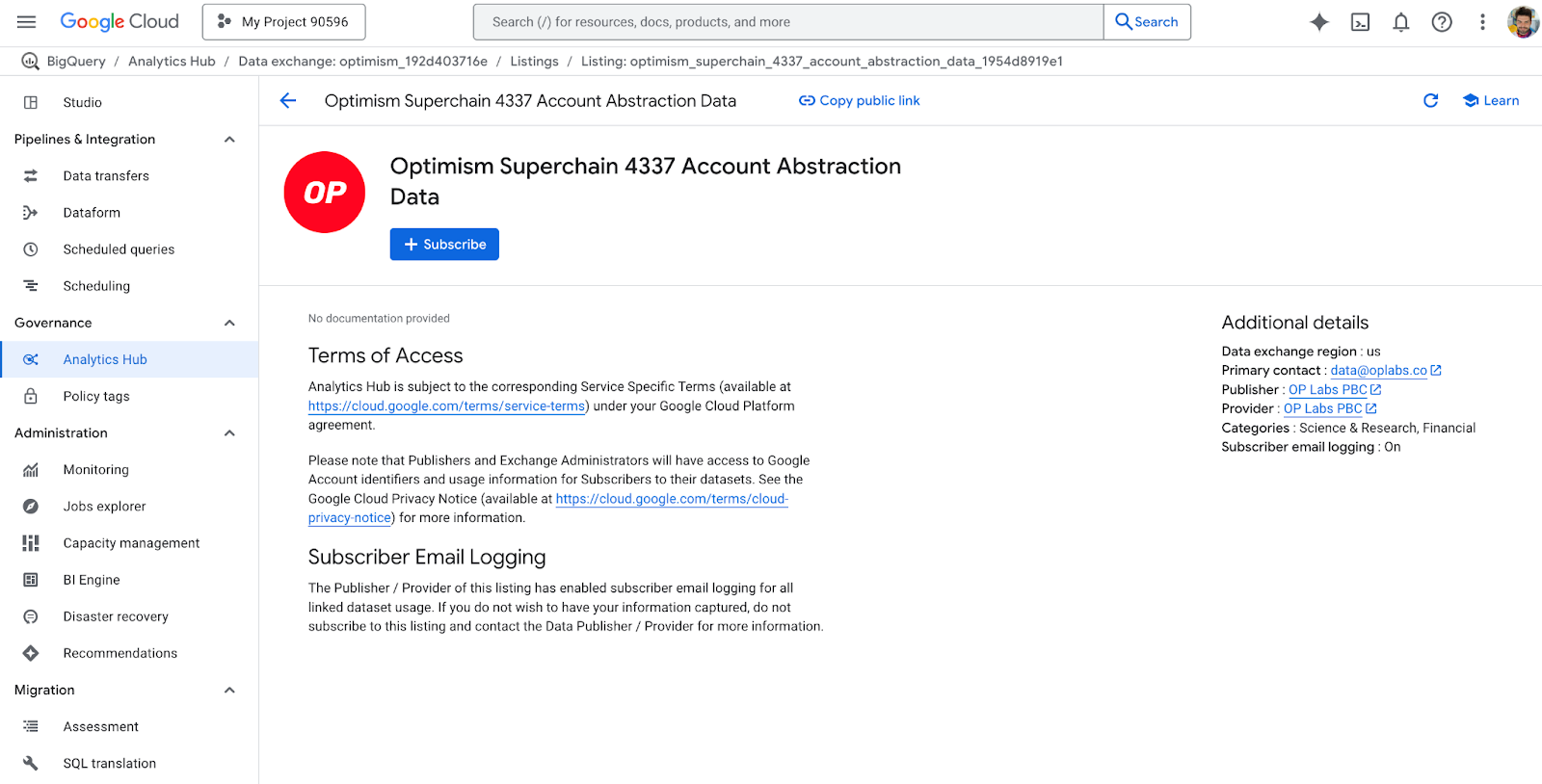
Once subscribed, you’ll be able to access your own workspace with tables linked to the original OP datasets. Then you can move to the “Studio” tab on the left and open a query editor that will give you instant access to the on-chain data. Let’s try to create our first query!
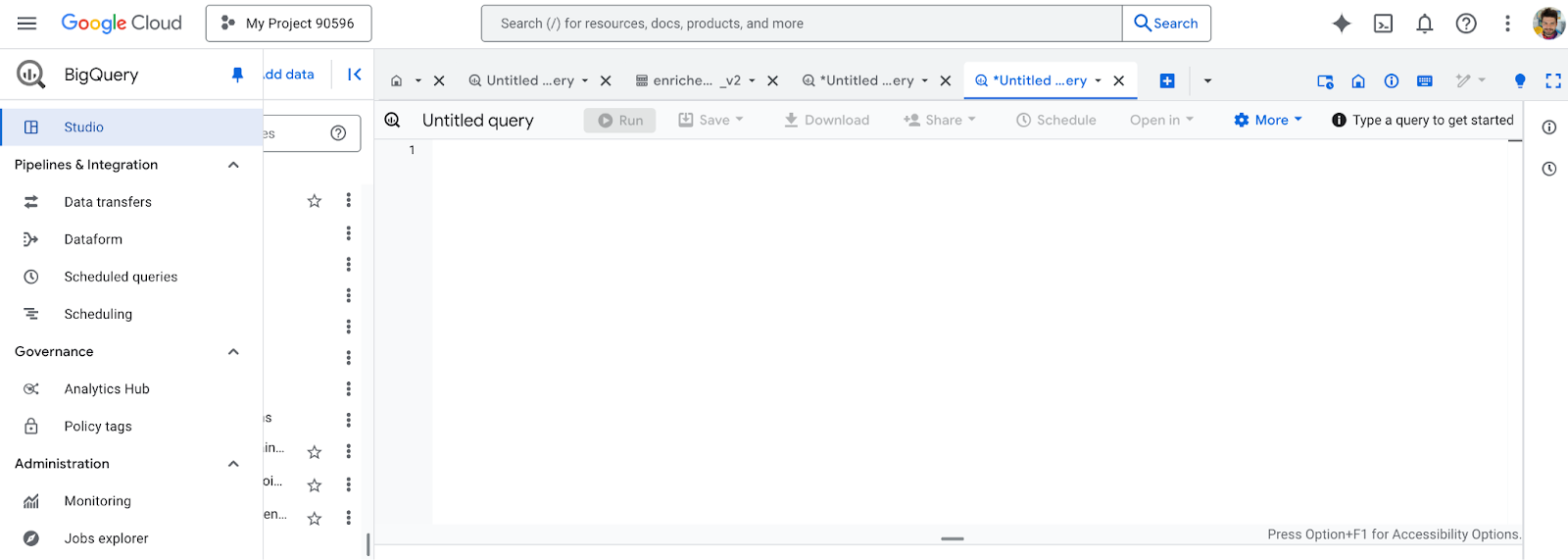
The goal of our query will be to understand how many unique users utilize the Account Abstraction feature on every Superchain network. In order to understand that, we will query 2 columns from the useroperationevent_logs_v2 table:
- chain (VARCHAR): The official name of the network according to the above list.
- sender (VARCHAR): Smart contract wallet that sent out the UserOp
With simple calculation of the number of unique occurrences of sender variable by using count(distinct(sender)) and grouping these by the chain name, we can easily create a table showing us which network leads in Account Abstraction adoption for a specific day or a period:
SELECT count(distinct(sender)) AS Total, chain FROM
`[our-database-name].optimism_superchain_4337_account_abstraction_data.useroperationevent_logs_v2`
WHERE dt = "2025-04-09" GROUP BY chain ORDER BY Total DESC
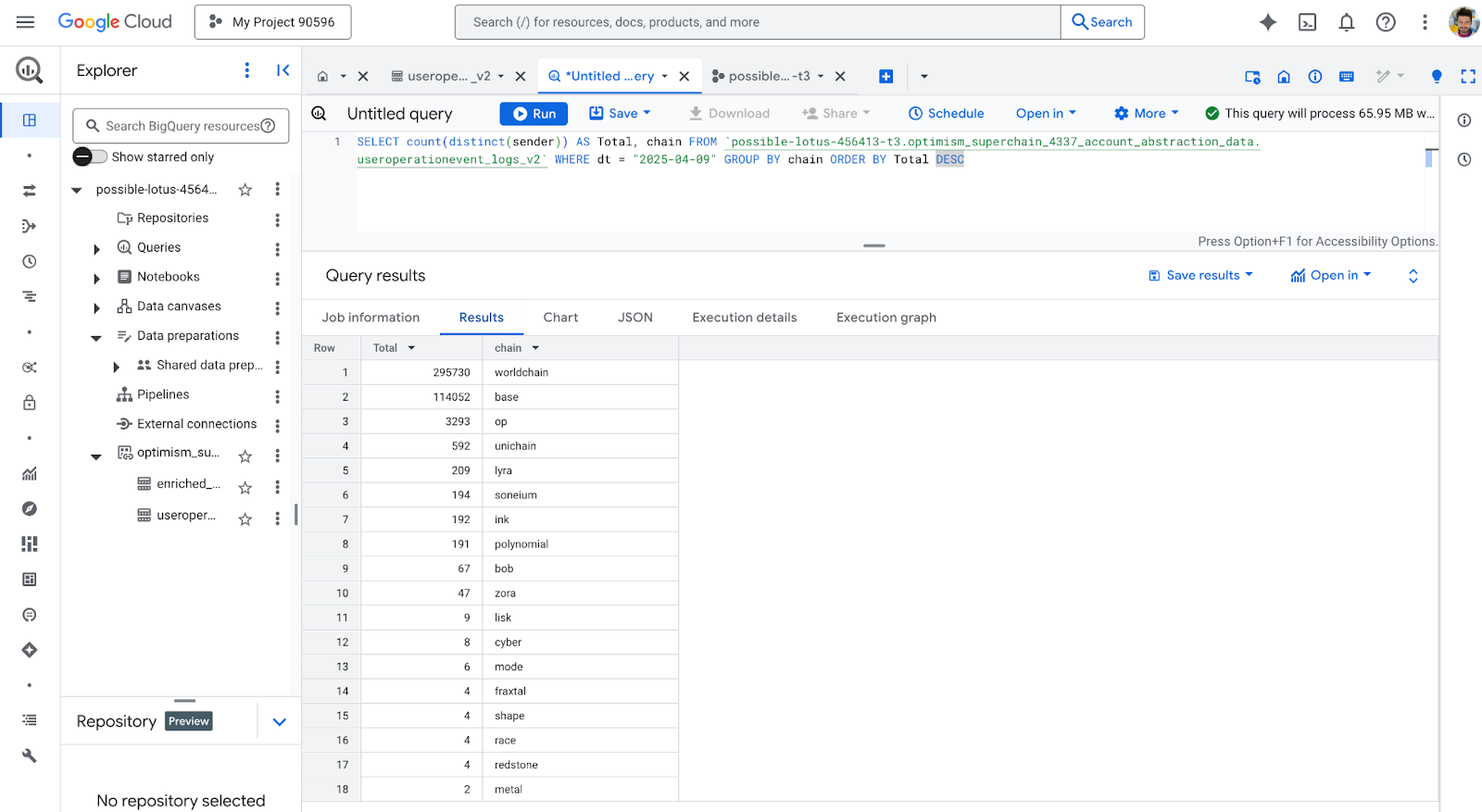
You can then save your query, share it or include it into a Notebook or Pipeline which are features specific for Google BigQuery. You can even easily generate a chart out of our data with inbuilt Google Query feature available behind the “Chart” tab:
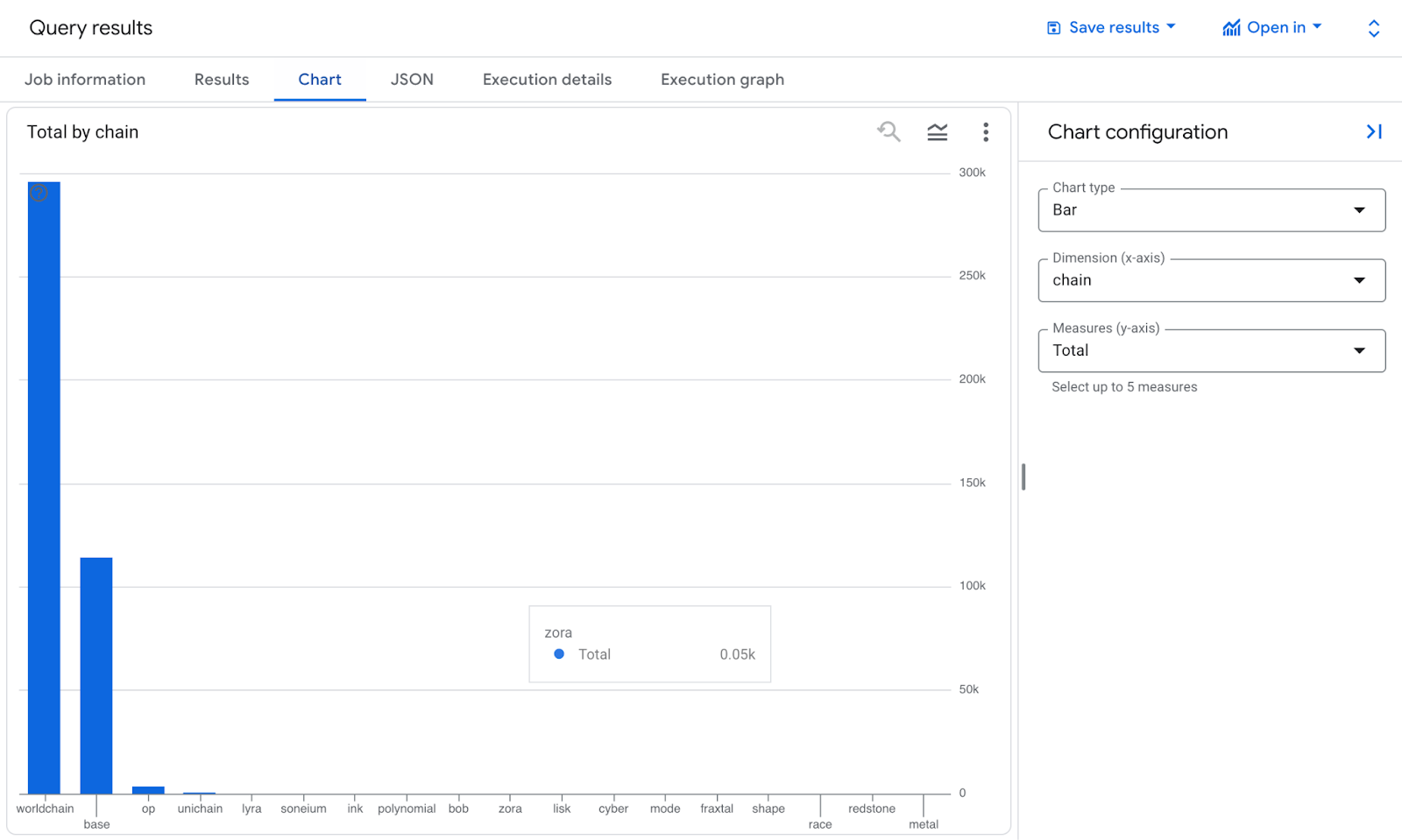
Using OP Foundation 4337 dataset and BundleBear labels¶
Now let’s try to utilize both datasets described in this article - OP Foundation 4337 dataset available in BigQuery and 4337 labels created by BundleBear available on Github available here.
For the sake of this example, let’s try to find out which Paymaster app is the leading one when it comes to daily gas coverage for smart contract wallets. Starting with a simple query we can easily preview all UserOps that happened with a use of a Paymaster - we just need to exclude all UserOps on Optimism during selected period where the column paymaster is equal to 0x0000000000000000000000000000000000000000 (which basically means that no Paymaster took part in executing the UserOp):
SELECT paymaster, actualGasCost FROM
`[our-dataset-name].optimism_superchain_4337_account_abstraction_data.useroperationevent_logs_v2`
WHERE dt = "2025-04-09" AND chain = 'op' AND NOT paymaster = '0x0000000000000000000000000000000000000000'
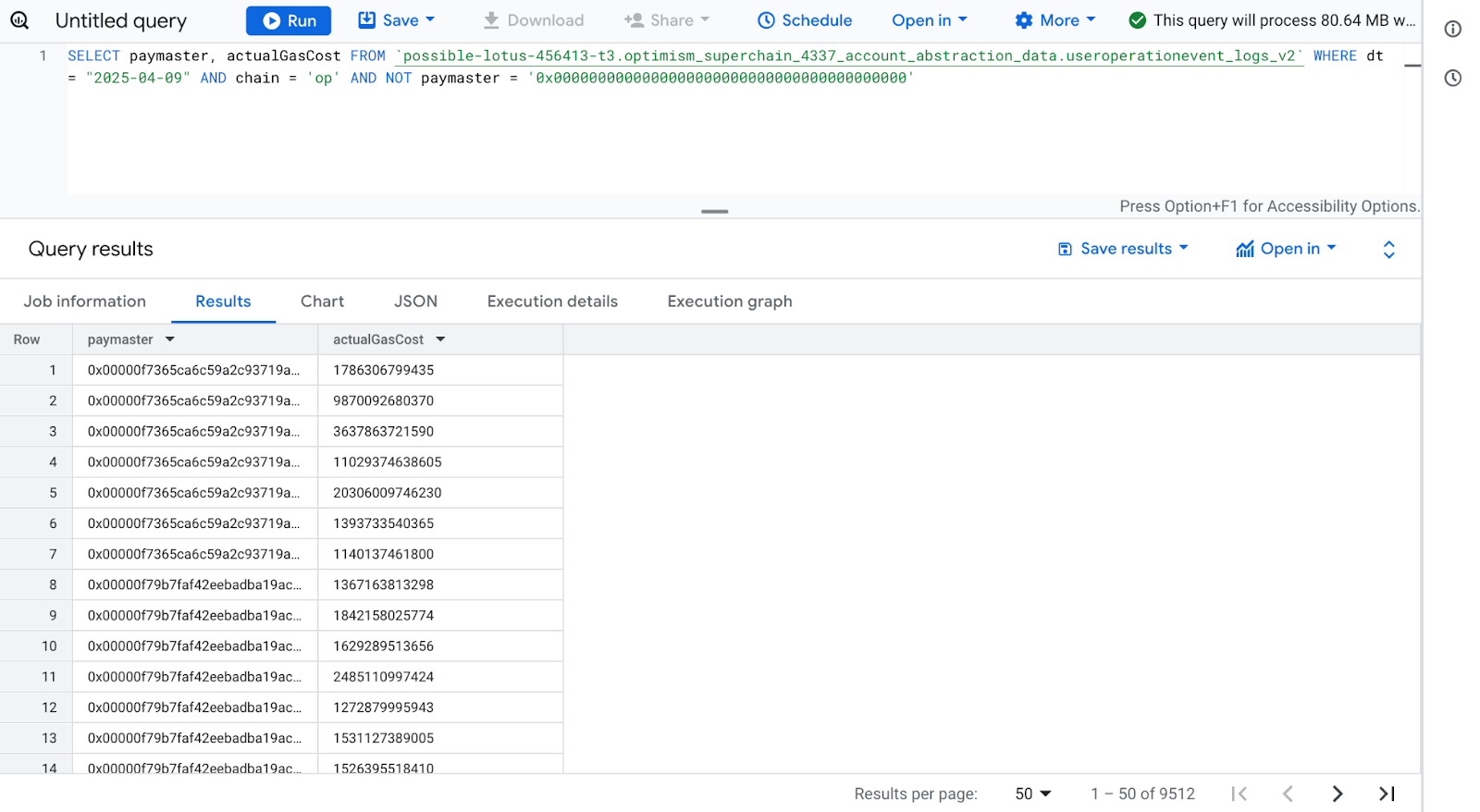
We now have a raw list of 9512 UserOps that happened on Optimism on a specific day with the use of Paymaster. Let’s sum the values for specific Paymaster addresses to see who’s the leader:
SELECT paymaster, sum(CAST(actualGasCost AS int)) AS Gas FROM
`[our-dataset-name].optimism_superchain_4337_account_abstraction_data.useroperationevent_logs_v2`
WHERE dt = "2025-04-09" AND NOT paymaster = '0x0000000000000000000000000000000000000000' GROUP BY Paymaster ORDER BY Gas DESC
The result is as follows - we can quickly preview that on this specific day there were 60 Paymaster contracts responsible for covering UserOps gas fees:
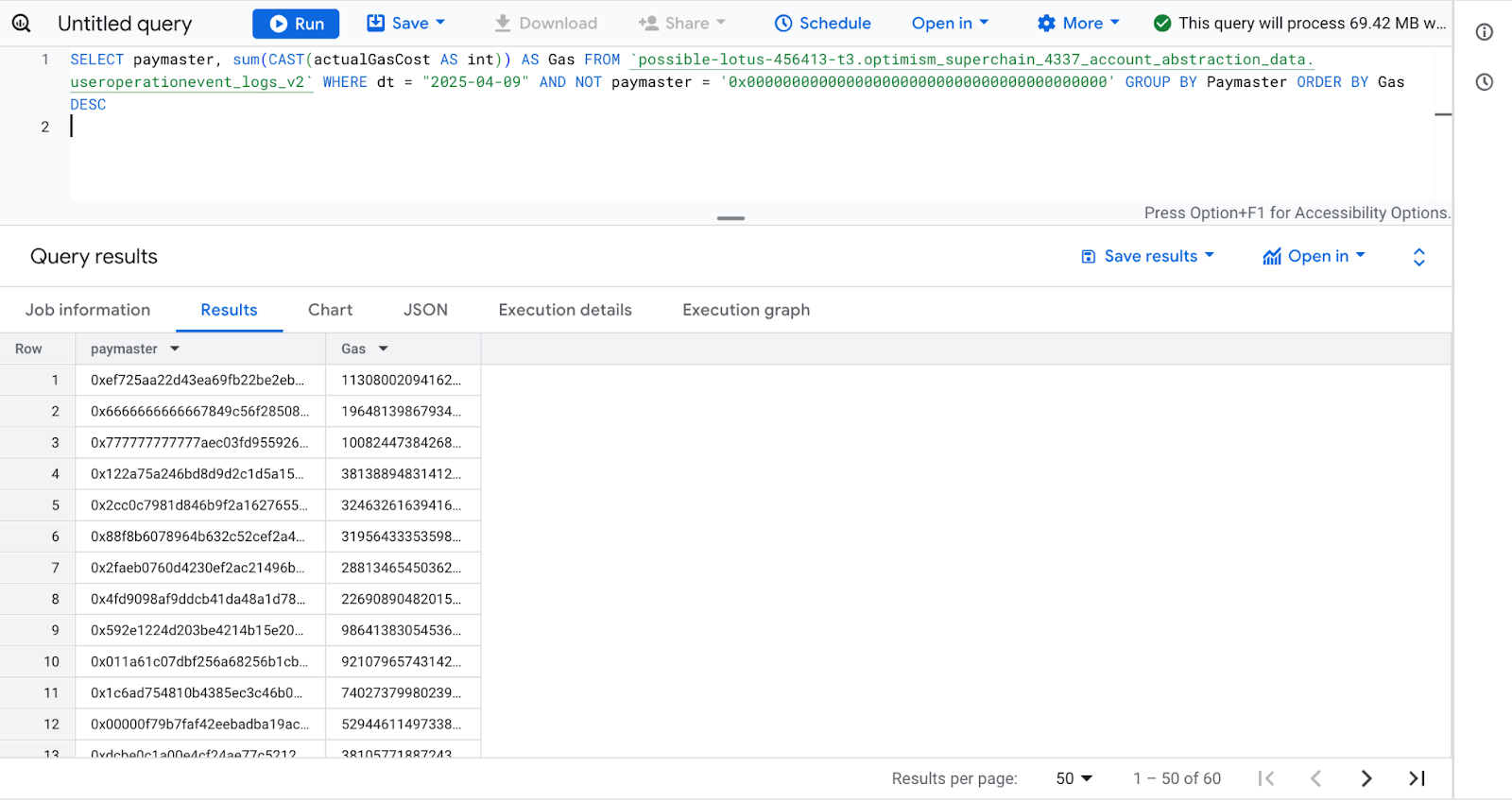
Now the only thing left to do is to map BundleBear’s Github labels onto the addresses above in order to understand who operates them. The quickest (not the most elegant however) way would be to create an additional table populated with labels:
CREATE TABLE [our-dataset-name].4337metrics.labels (
name STRING,
paymaster STRING,
type STRING,
);
Mapping all the columns exactly as in the Github repo allows us to copy paste the whole file and populate the table with labels in seconds:
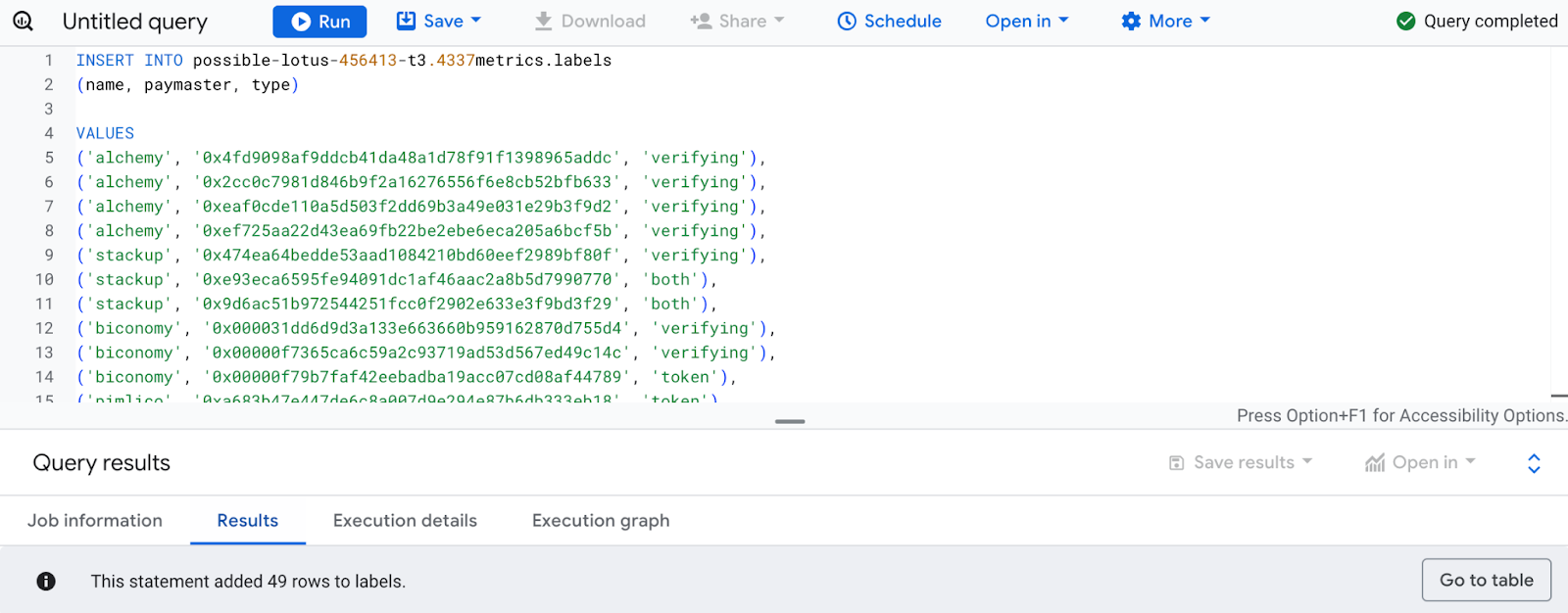
The only thing left is to create a query that selects paymaster data from both tables (useroperationevent_logs_v2 and labels), sums the actualGasCost as in our previous example and then combines both tables using LEFT JOIN and grouping by Paymaster name:
SELECT
labels.name AS Name,
sum(CAST(opdata.actualGasCost AS numeric)) AS Gas,
FROM
`4337metrics.labels` AS labels,
`[our-dataset-name].optimism_superchain_4337_account_abstraction_data.useroperationevent_logs_v2` AS opdata
LEFT JOIN `4337metrics.labels`
ON opdata.paymaster = labels.paymaster
WHERE opdata.dt = "2025-04-09" AND NOT opdata.paymaster = '0x0000000000000000000000000000000000000000' GROUP BY Name
The resulting data shows which Paymaster application has the biggest volume of covered gas costs on a specific day. As in the previous example, you can easily generate a chart out of this data:
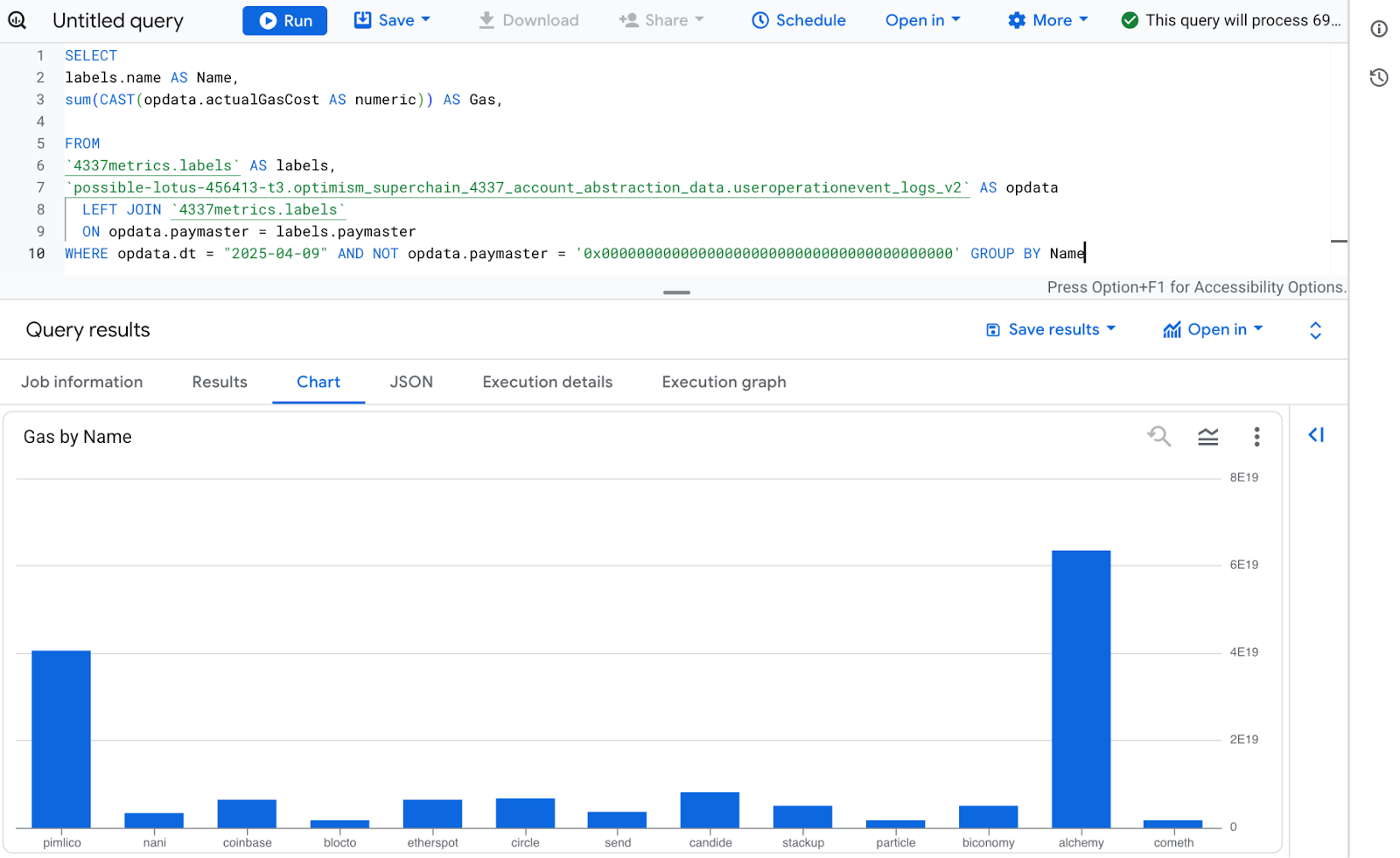
Using OSO's pyoso library for 4337 data analysis¶
For a more streamlined approach to analyzing Account Abstraction data, you can use OSO's pyoso library which provides direct access to curated 4337 datasets across all Superchain networks. This approach eliminates the need for BigQuery setup -- and lets you connect 4337 data with 100s of other public data models.
Getting Started with pyoso¶
First, you'll need to get an API key to access the data.
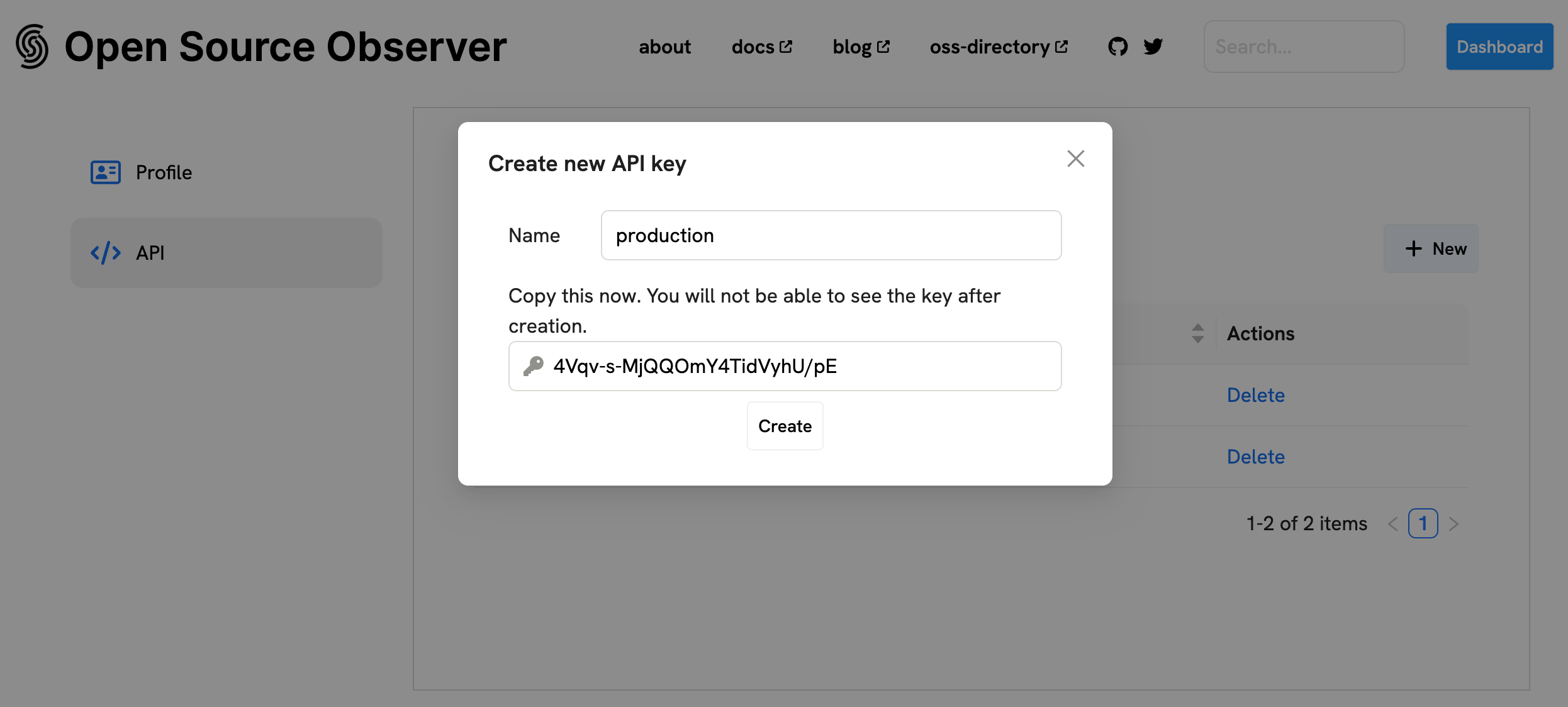
Then, install the pyoso library and set up your environment:
pip install pyoso
Initialize the client:
import pandas as pd
from pyoso import Client
# Set up the OSO client
OSO_API_KEY = "YOUR_API_KEY"
client = Client(api_key=OSO_API_KEY)
Available 4337 Data Models¶
OSO hosts lighter weight "staging" versions of the same tables shared above:
- Enriched EntryPoint Traces (
stg_superchain__4337_traces) - User Operation Logs (
stg_superchain__4337_userop_logs) - OLI Address Labels (
stg_openlabelsinitiative__labels_decoded)
Example: Analyzing Paymaster Usage¶
Here's how to analyze paymaster usage across all Superchain networks:
# Get daily paymaster usage by project and chain
df_paymaster_usage = client.to_pandas("""
WITH paymasters AS (
SELECT address
FROM stg_openlabelsinitiative__labels_decoded
WHERE tag_id = 'is_paymaster'
),
labeled_paymasters AS (
SELECT
address,
MIN(tag_value) AS owner_project
FROM stg_openlabelsinitiative__labels_decoded
WHERE
tag_id = 'owner_project'
AND address IN (SELECT address FROM paymasters)
GROUP BY 1
)
SELECT
DATE_TRUNC('DAY', block_timestamp) AS bucket_day,
COALESCE(p.owner_project, 'unknown') AS owner_project,
chain,
COUNT(*) AS userops_count
FROM stg_superchain__4337_userop_logs AS logs
LEFT JOIN labeled_paymasters AS p ON logs.paymaster_address = p.address
GROUP BY 1,2,3
ORDER BY bucket_day DESC, userops_count DESC
""")
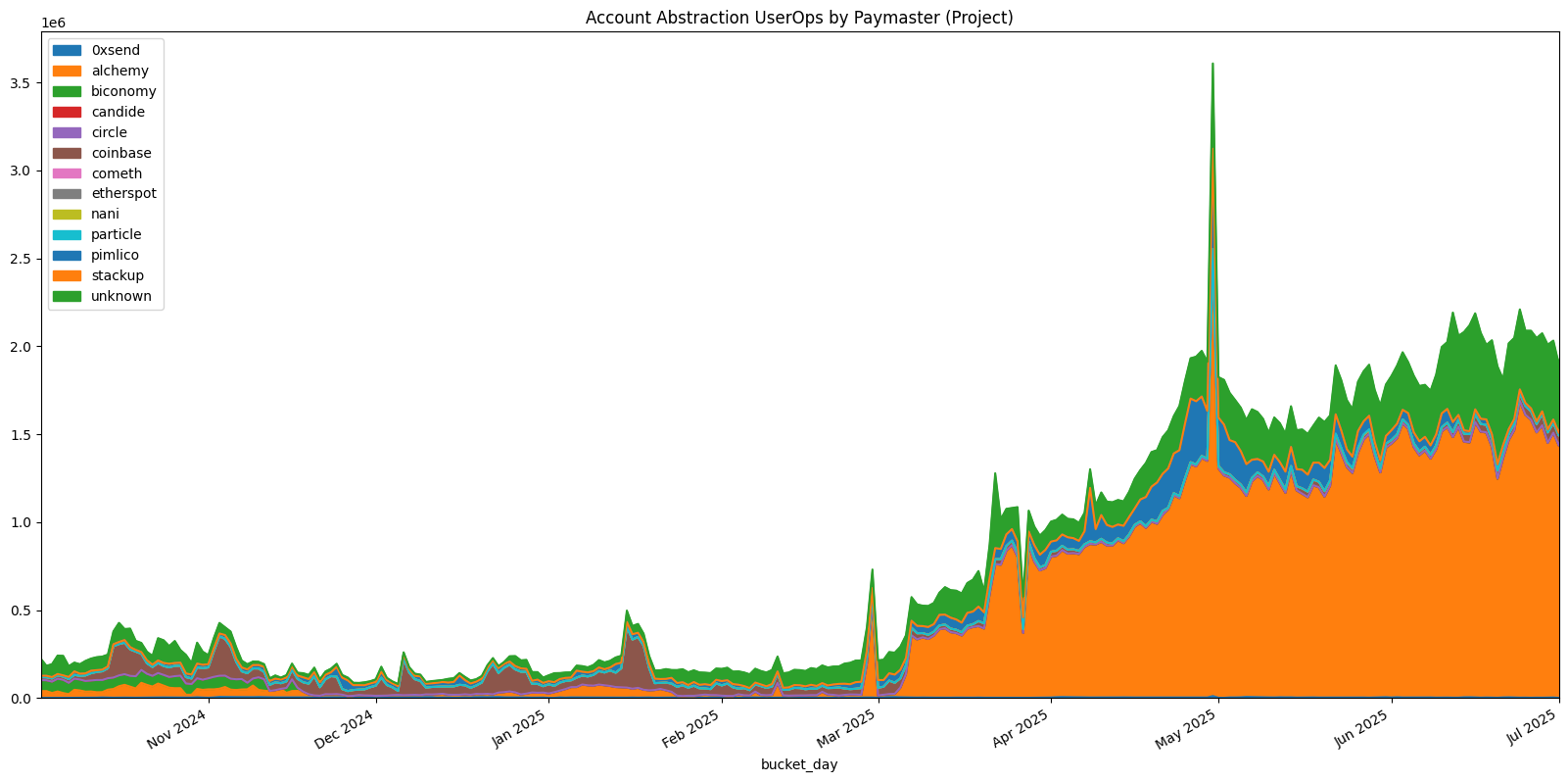
Example: Chain-by-Chain Activity Analysis¶
Analyze Account Abstraction activity across different Superchain networks:
# Get total activity by chain
df_chain_totals = client.to_pandas("""
SELECT
chain,
COUNT(*) AS total_userops,
COUNT(DISTINCT sender_address) AS unique_users,
COUNT(DISTINCT paymaster_address) AS unique_paymasters,
AVG(userop_gas_used) AS avg_gas_used,
SUM(userop_gas_used * userop_gas_price) / 1e18 AS total_gas_cost_eth
FROM stg_superchain__4337_userop_logs
WHERE paymaster_address != '0x0000000000000000000000000000000000000000'
GROUP BY chain
ORDER BY total_userops DESC
""")
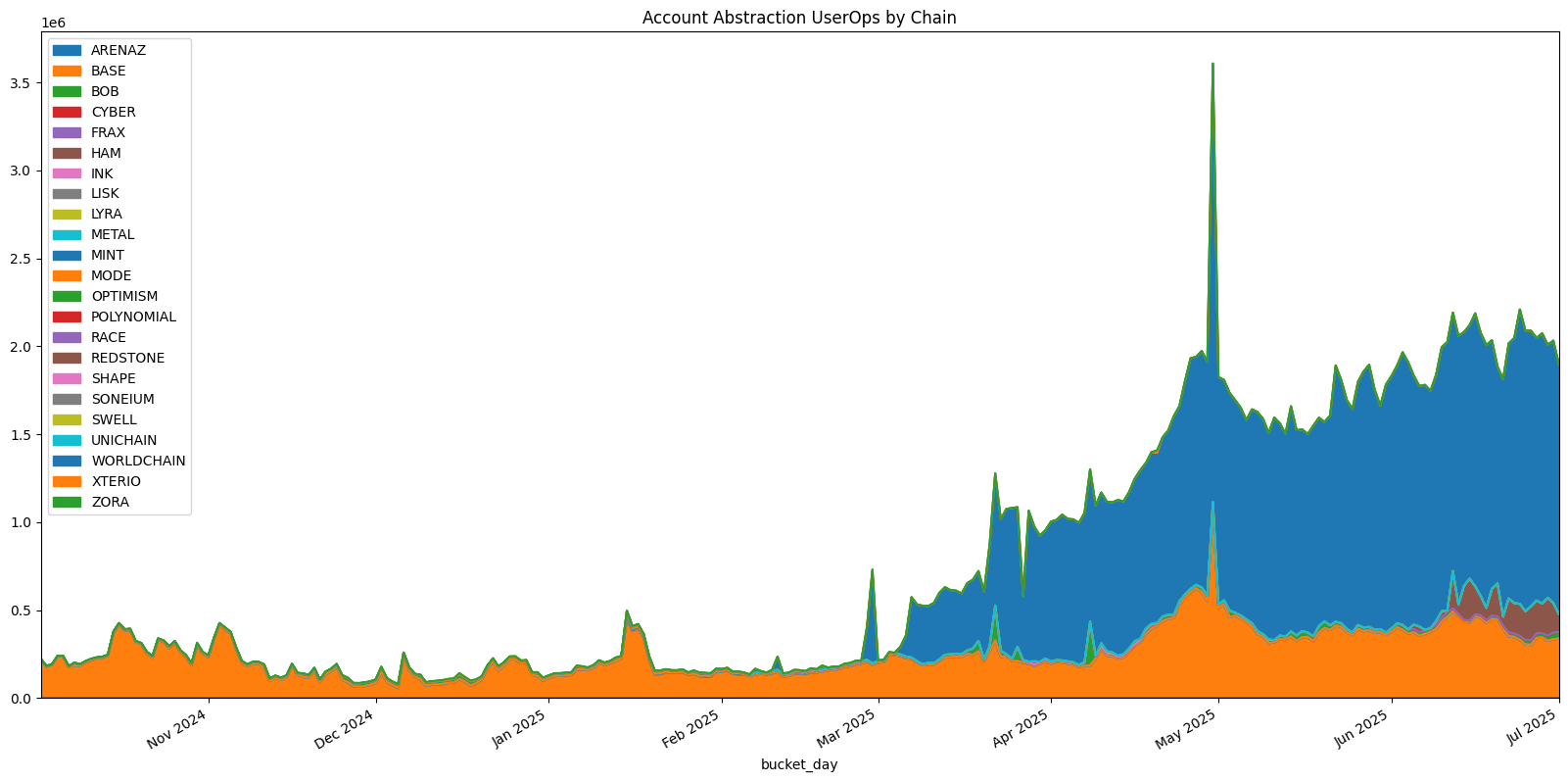
For a longer tutorial on Account Abstraction analysis using pyoso, check out the Monitor Account Abstraction Adoption tutorial which covers user operations, paymaster analysis, and cross-chain activity patterns.
Thanks for reading and feel free to outreach to Superchain 4337 Team in case any questions or ideas arise!